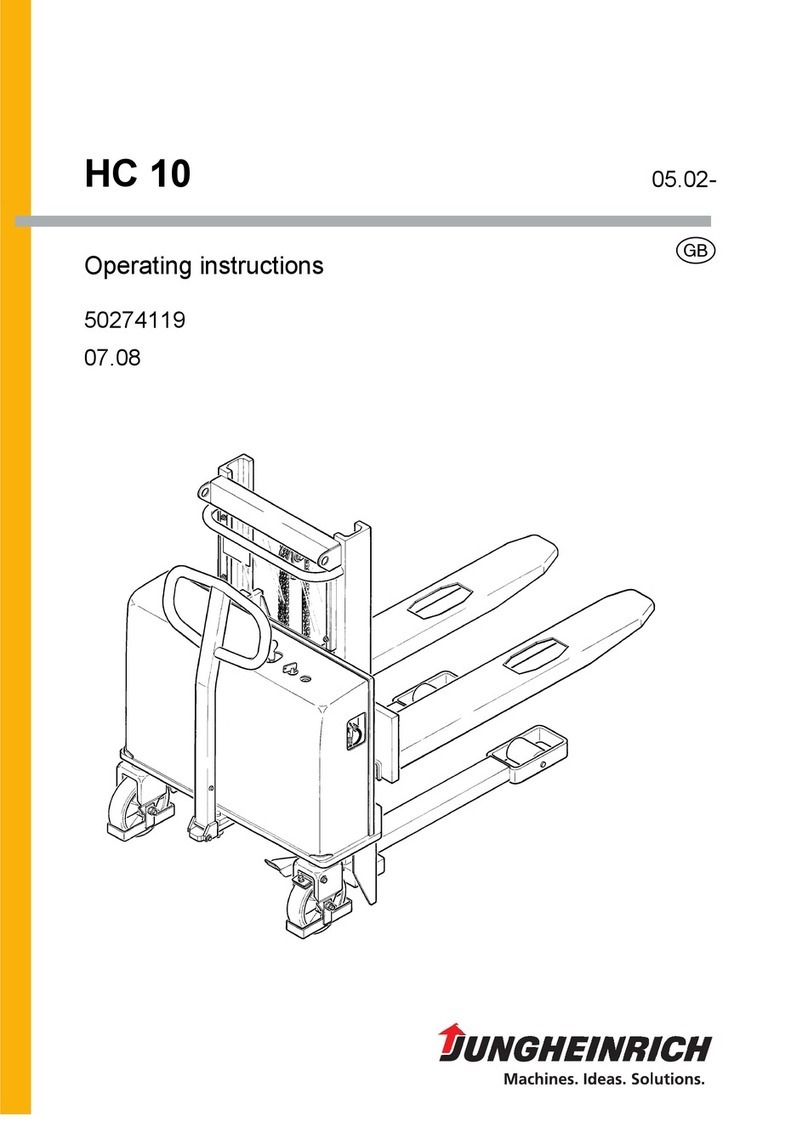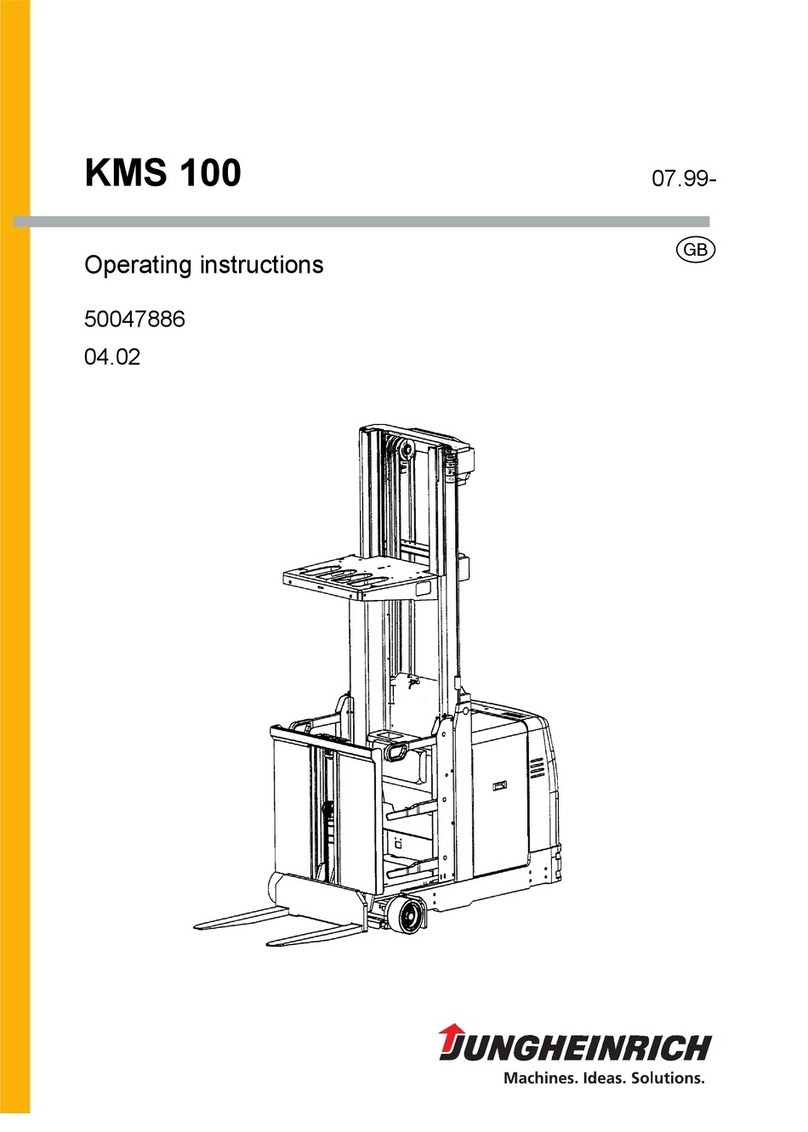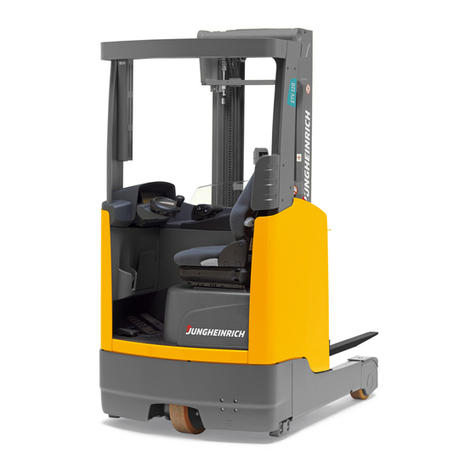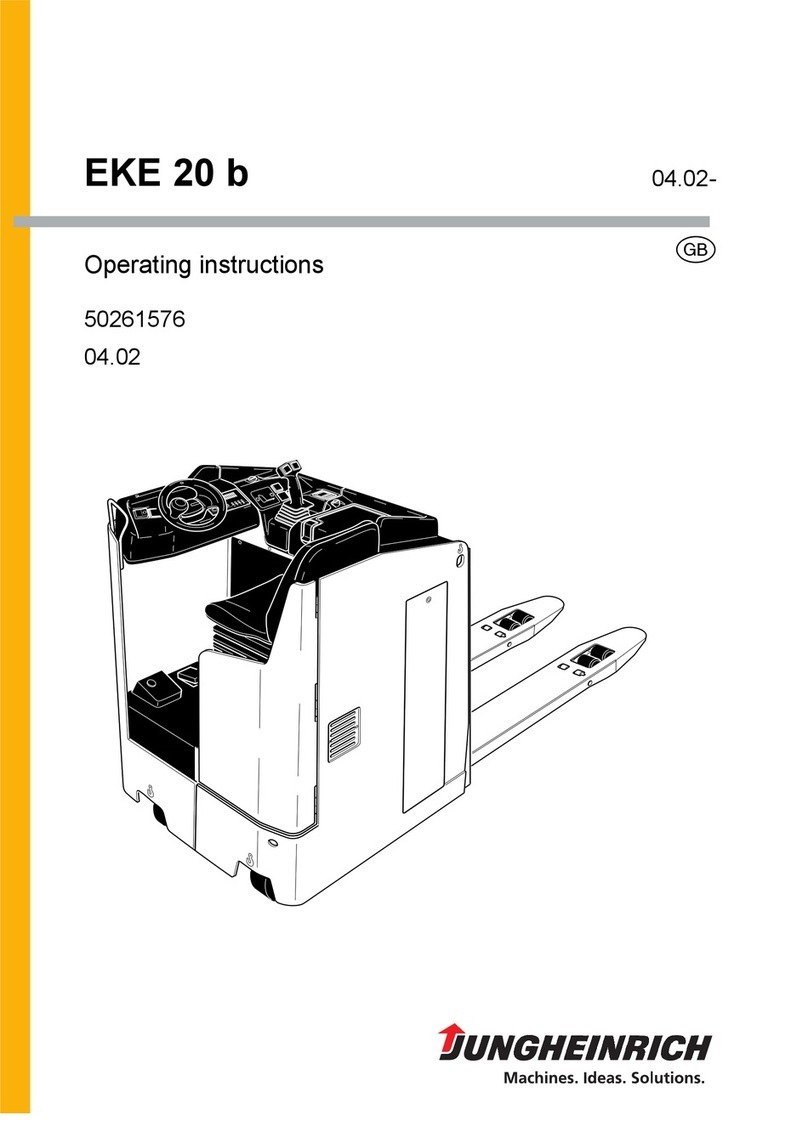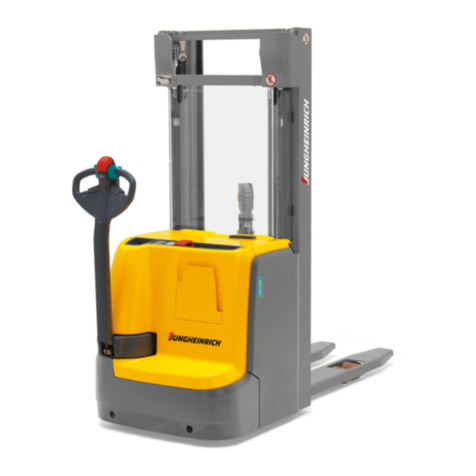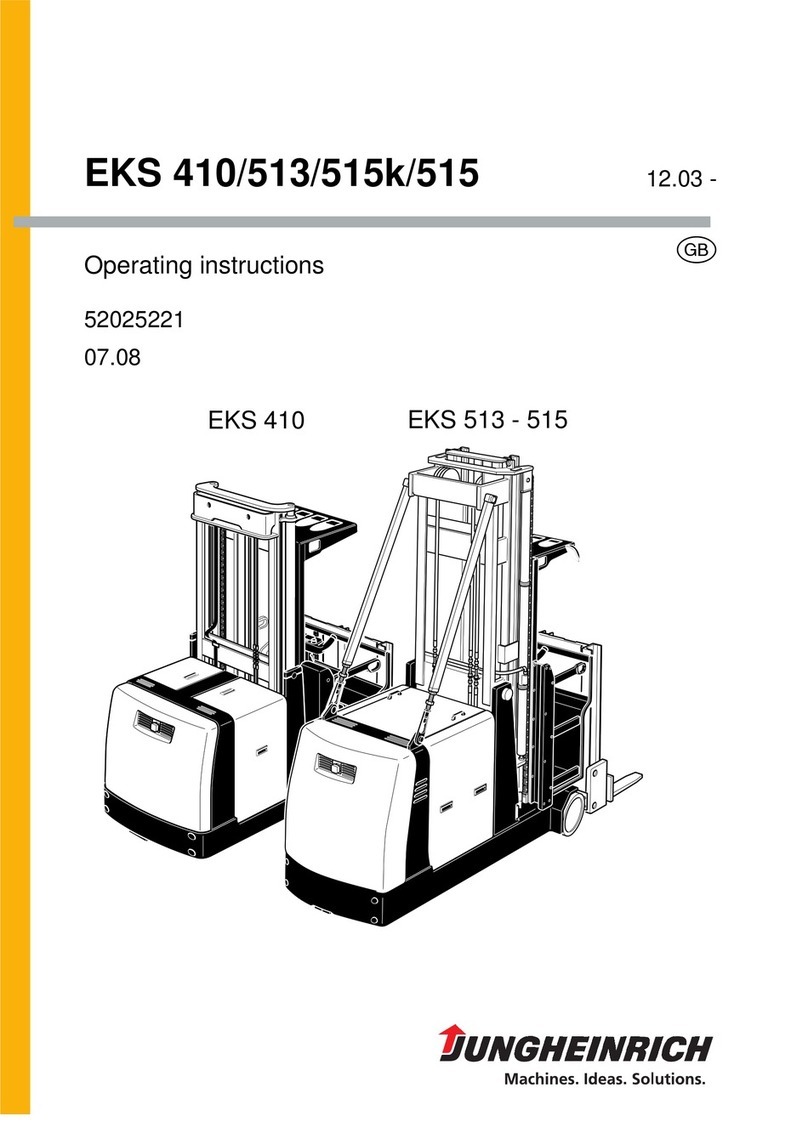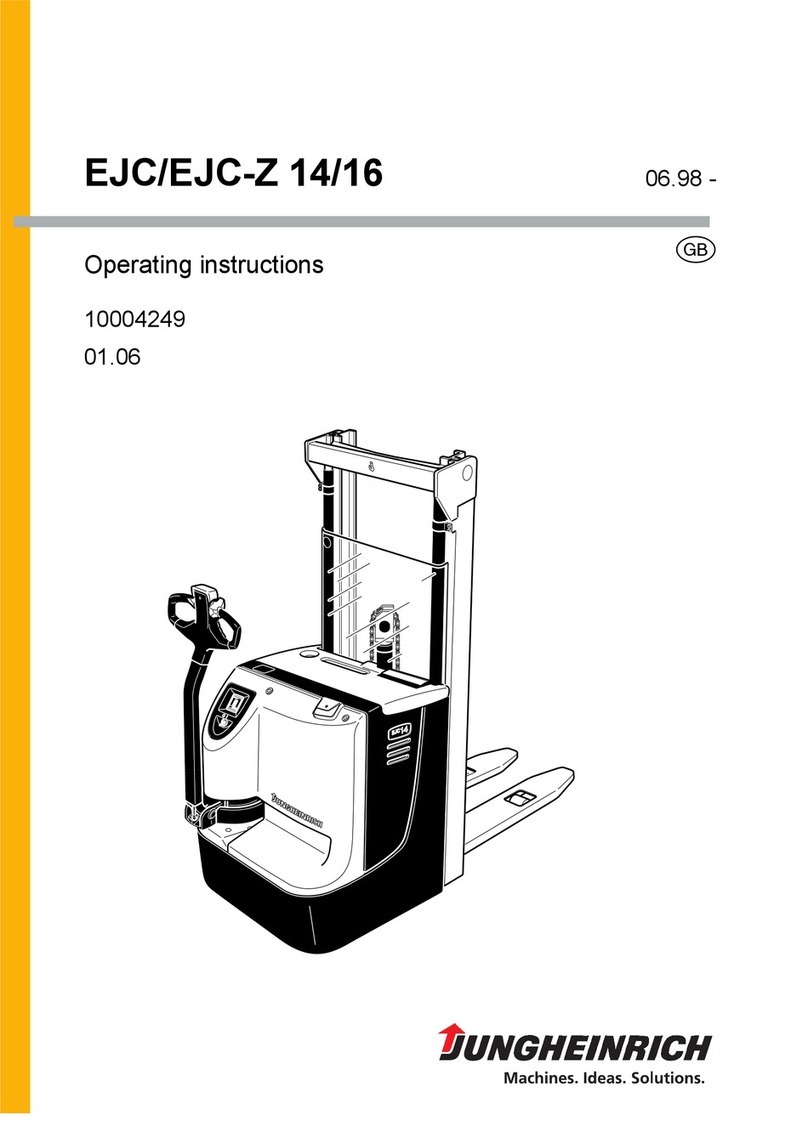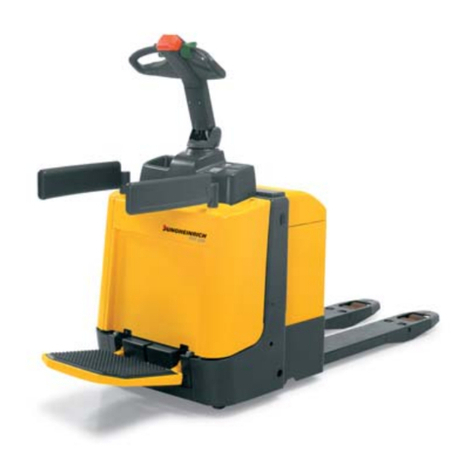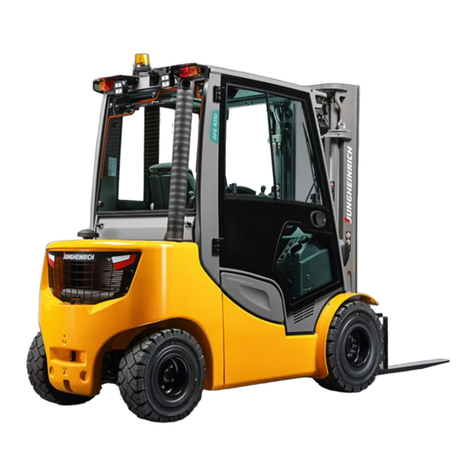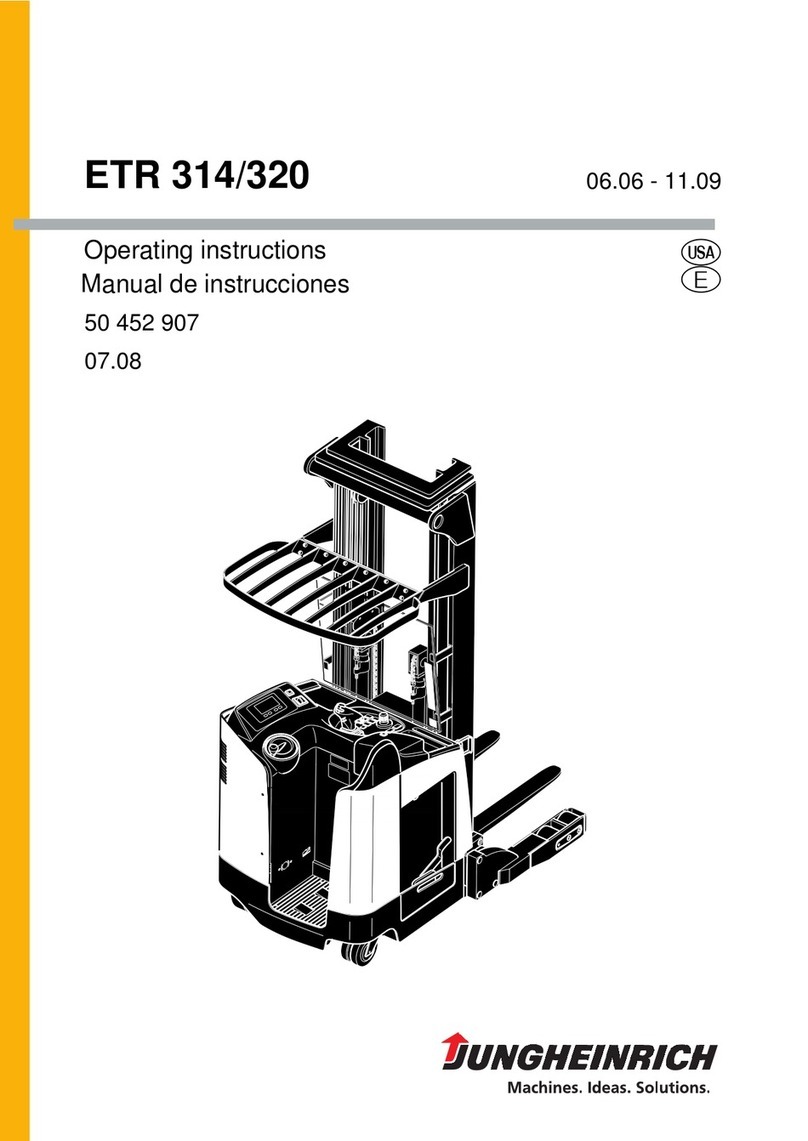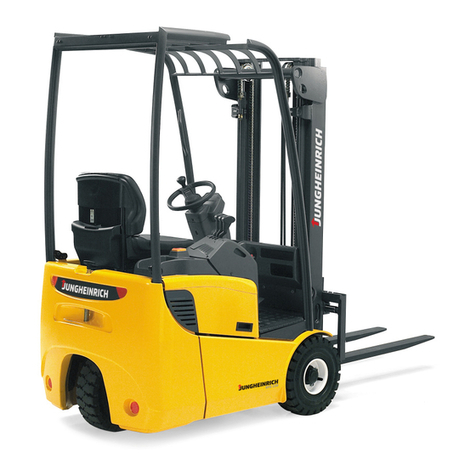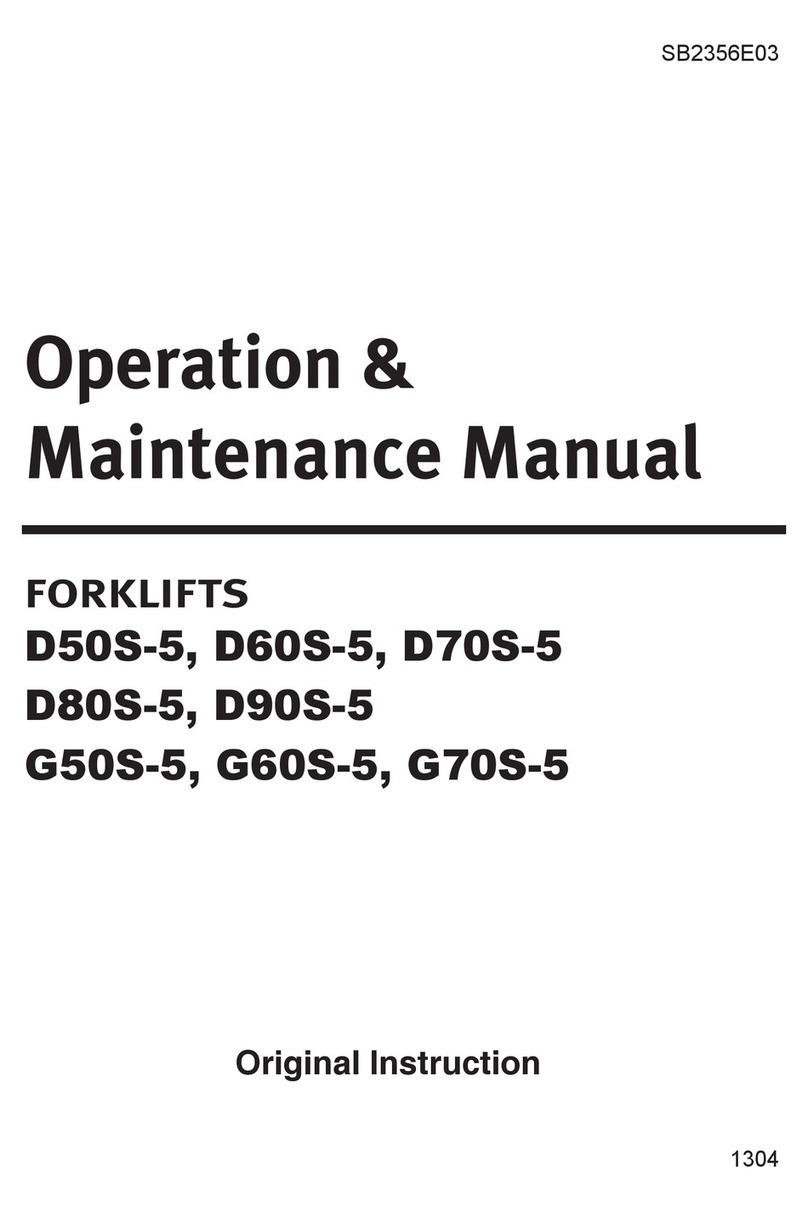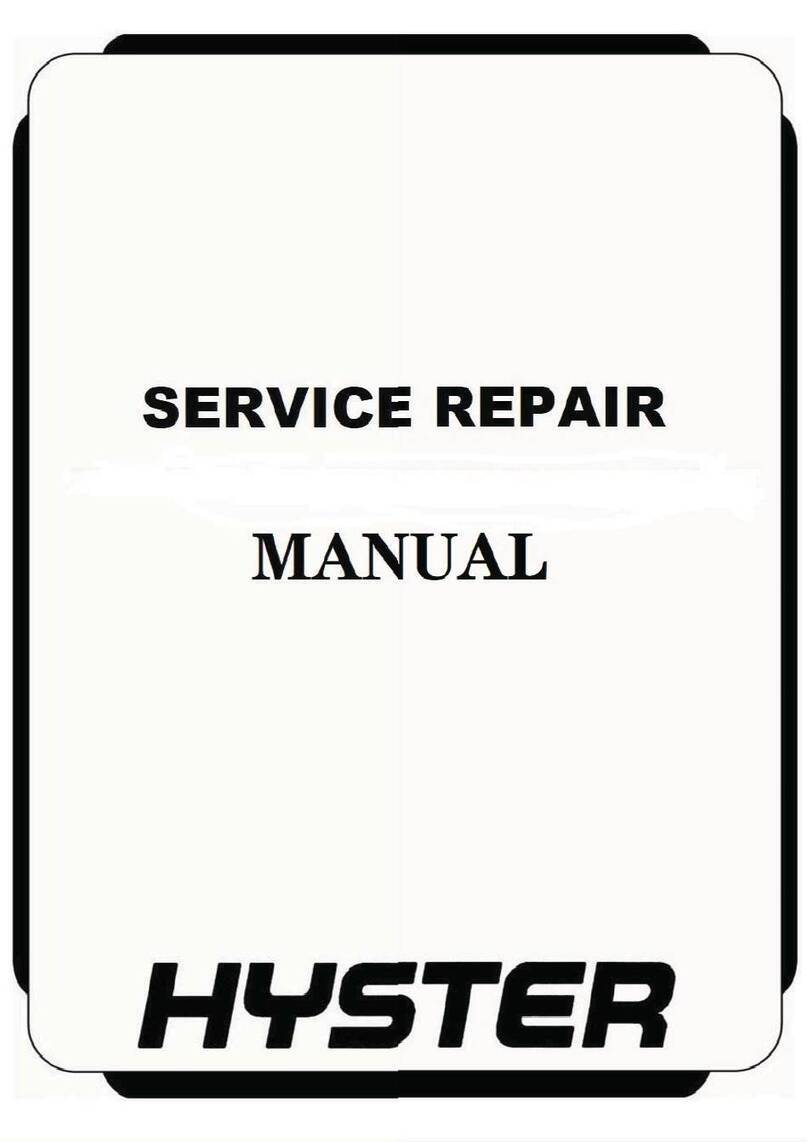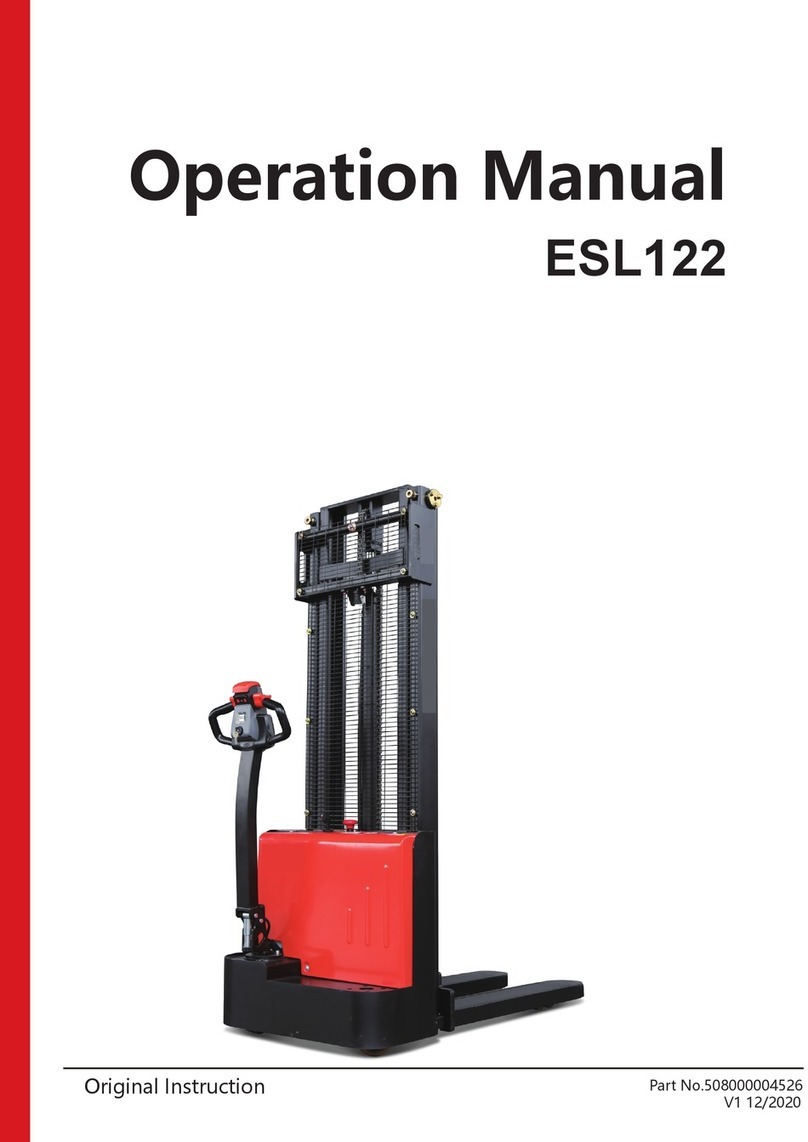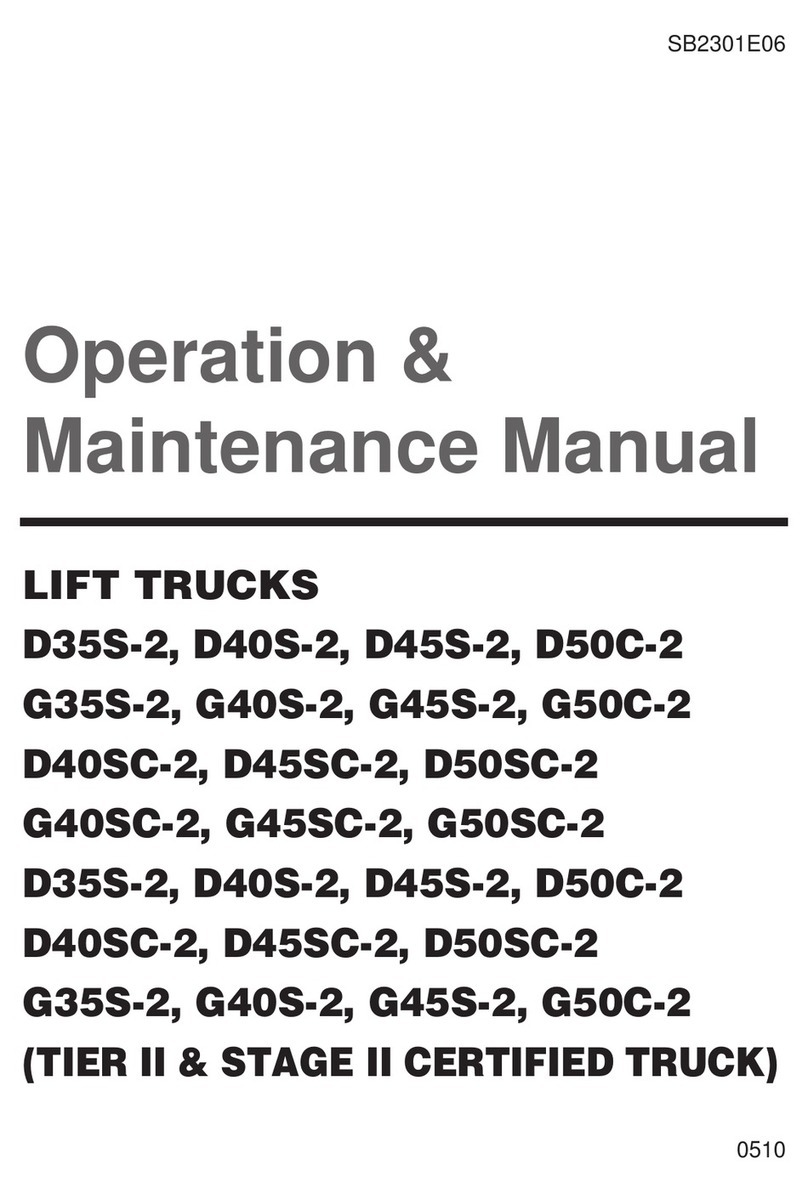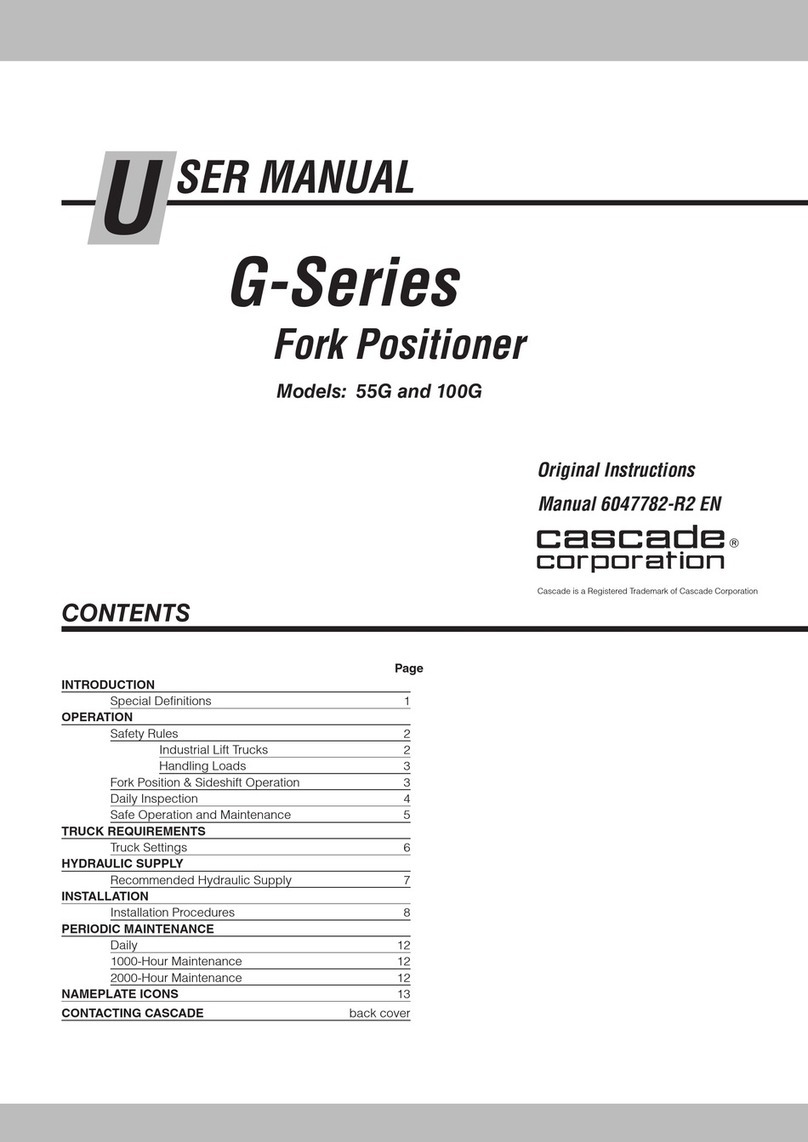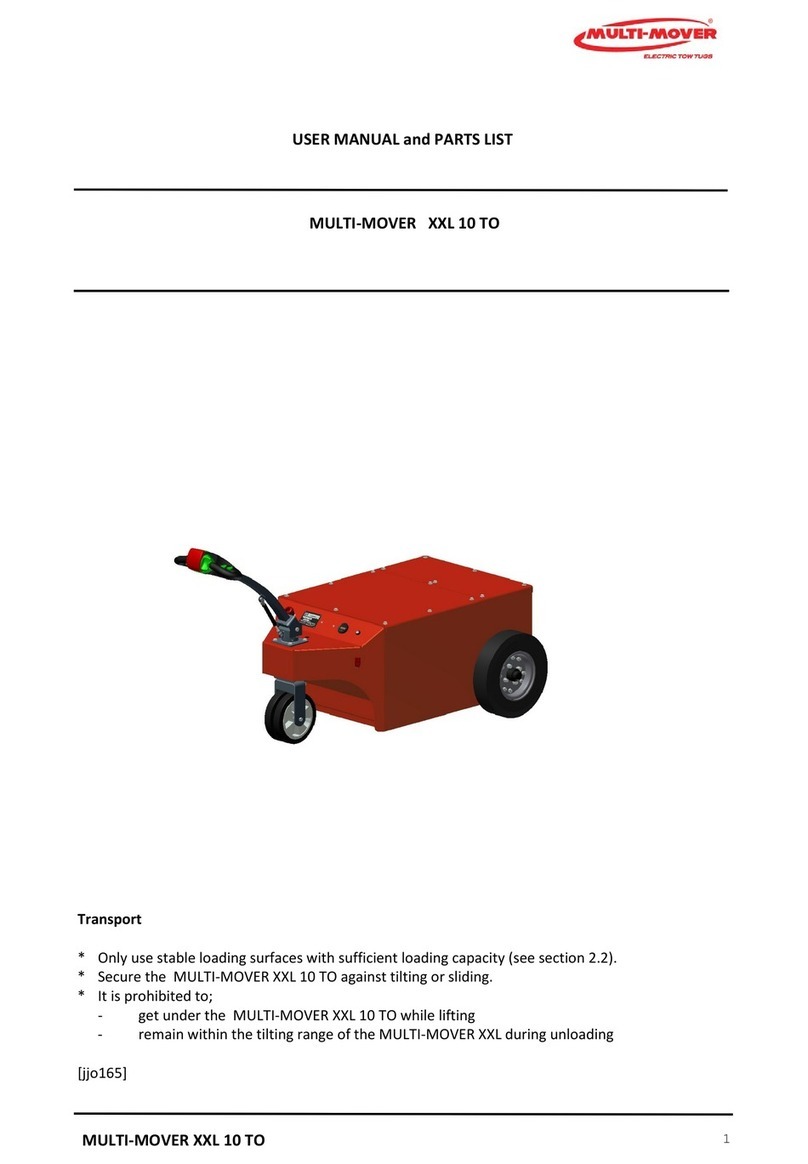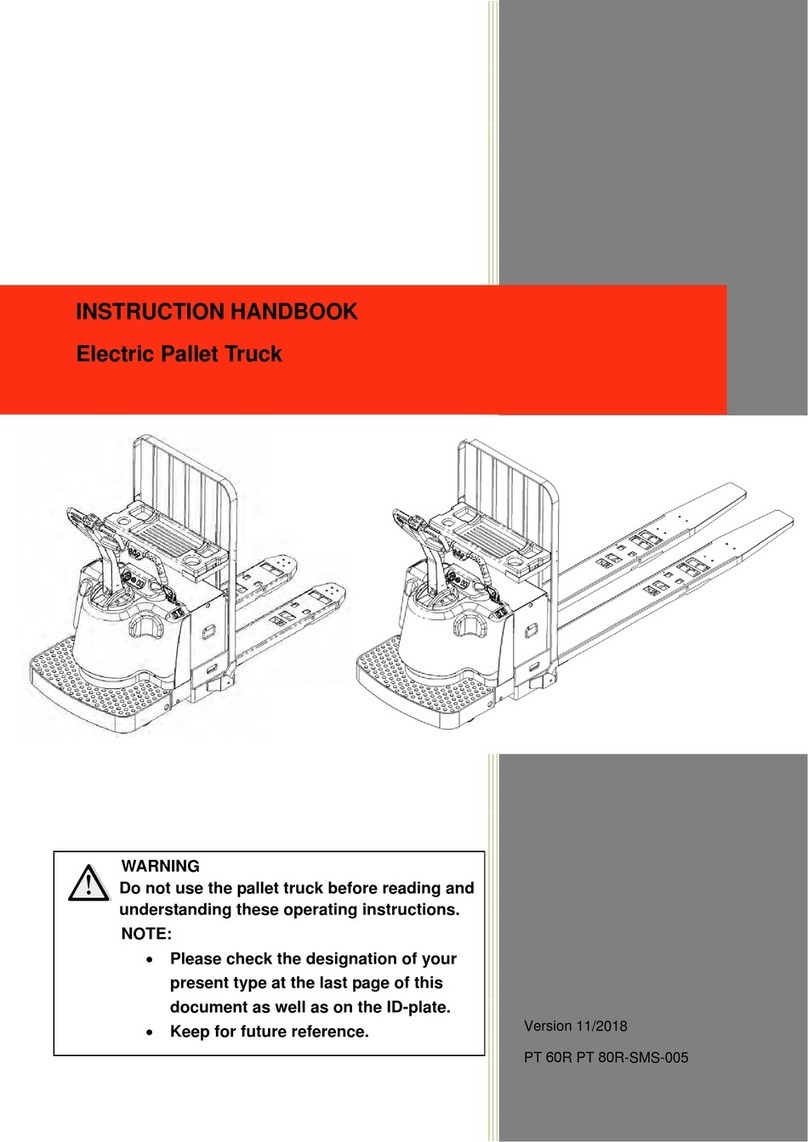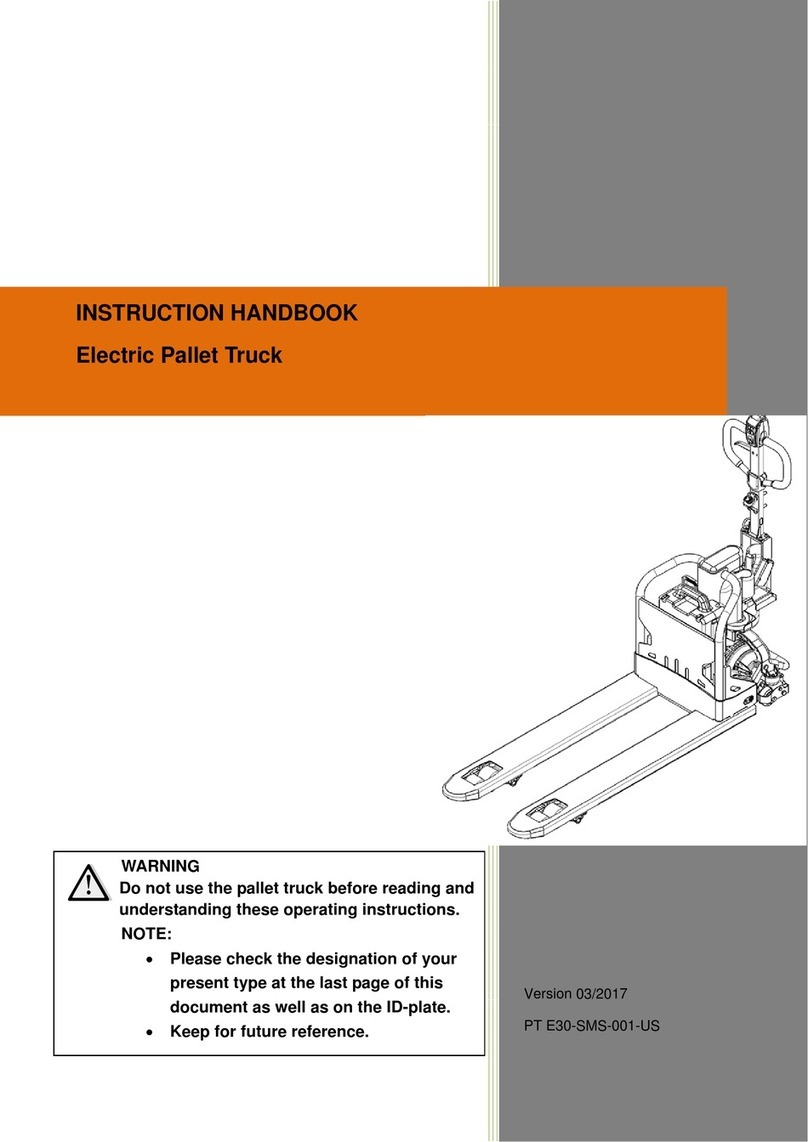B3
1206.GB
2.1 Truck
Frame and Superstructure: A stable, torsionally rigid frame in which the equipment
and controls are installed protected, gives the truck a high static safety. The driver’s cab
is spring--mounted to dampen vibrations and noise.
A wide--opening top and two side panels on the engine cover (11) allow easy
maintenance and service. The hydraulic oil tank is side integrated into the frame on the
right and the fuel tank for the DFG series on the opposite side. The gas bottles for the
TFG series are attached to the counterweight (9) in a holder. The vertical free--standing
exhaust pipe which opens high above the machine prevents the transmission of
vibration and sound waves and the penetration of exhaust gases into the driver’s cab.
Driver’s Cab: Non--slip steps and a handle on the roof pillar ensure easy entrance and
exit. The driver is protected by the roof (6). On the driver’s seat (7), the seat cushioning
and position are adjustable, and on the steering column (5) the angle of the steering
wheel can be modified. Simple operation by ergonomically arranged controls and a
virtually vibration--free driver’s cab means that minimum load is exerted on the driver.
The control and warning displays on the instrument panel (4) allow monitoring of the
systems during operation. As a result, the safety standard is very high.
The driver’s overhead guard must be checked prior to starting the truck for cracks, and
if damaged, must be repaired or replaced.
Engine: A silent water--cooled engine with high power and low fuel consumption. The
DFG series are fitted with diesel engines with very clean combustion under all
operating conditions and with low soot output. In the TFG series, liquid petroleum gas
engines are fitted with a very low residual exhaust value.
Drive: A load gearbox with gear oil cooler and torque converter is flanged directly onto
the engine. This transfers the power to the drive axle (12).
The direction lever on the operating console selects forwards/reverse or neutral.
Steering: Hydrostatic steering with a steering cylinder integrated into the steering axle
(10). The steering axle is fully floating in the frame to ensure good ground holding even
on uneven surfaces.
Brakes: The creep/brake pedal operates two hydraulic drum brakes acting on the drive
wheels. The drum brakes adjust automatically for wear. The parking brake acts
mechanically via Bowden cables on the drum brakes when the parking brake lever is
operated.
Wheels: All wheels are within the truck contour. The tyres are either pneumatic or
super--elastic tyres.
Hydraulic System: The hydraulic system gear pump is driven by the engine via the
secondary take--off from the load gears. The pump speed and hence the transport
volume is controlled by the engine speed via the accelerator pedal.
The hydraulic functions are controlled by the control lever via a multiple control valve.
Electrical System: 12 Volt system with starter battery and 3--phase alternator with
integral regulator. The starting repeat block prevents incorrect operation during
starting and a safety circuit allows the engine to start only when the direction lever is in
neutral. For diesel engines, a fast preglow system is fitted, whereas LPG engines have
a contactless electronic ignition system for fast easy starting of the engine. The engine
is turned off using the ignition/starter switch.
f
B3
1206.GB
2.1 Truck
Frame and Superstructure: A stable, torsionally rigid frame in which the equipment
and controls are installed protected, gives the truck a high static safety. The driver’s cab
is spring--mounted to dampen vibrations and noise.
A wide--opening top and two side panels on the engine cover (11) allow easy
maintenance and service. The hydraulic oil tank is side integrated into the frame on the
right and the fuel tank for the DFG series on the opposite side. The gas bottles for the
TFG series are attached to the counterweight (9) in a holder. The vertical free--standing
exhaust pipe which opens high above the machine prevents the transmission of
vibration and sound waves and the penetration of exhaust gases into the driver’s cab.
Driver’s Cab: Non--slip steps and a handle on the roof pillar ensure easy entrance and
exit. The driver is protected by the roof (6). On the driver’s seat (7), the seat cushioning
and position are adjustable, and on the steering column (5) the angle of the steering
wheel can be modified. Simple operation by ergonomically arranged controls and a
virtually vibration--free driver’s cab means that minimum load is exerted on the driver.
The control and warning displays on the instrument panel (4) allow monitoring of the
systems during operation. As a result, the safety standard is very high.
The driver’s overhead guard must be checked prior to starting the truck for cracks, and
if damaged, must be repaired or replaced.
Engine: A silent water--cooled engine with high power and low fuel consumption. The
DFG series are fitted with diesel engines with very clean combustion under all
operating conditions and with low soot output. In the TFG series, liquid petroleum gas
engines are fitted with a very low residual exhaust value.
Drive: A load gearbox with gear oil cooler and torque converter is flanged directly onto
the engine. This transfers the power to the drive axle (12).
The direction lever on the operating console selects forwards/reverse or neutral.
Steering: Hydrostatic steering with a steering cylinder integrated into the steering axle
(10). The steering axle is fully floating in the frame to ensure good ground holding even
on uneven surfaces.
Brakes: The creep/brake pedal operates two hydraulic drum brakes acting on the drive
wheels. The drum brakes adjust automatically for wear. The parking brake acts
mechanically via Bowden cables on the drum brakes when the parking brake lever is
operated.
Wheels: All wheels are within the truck contour. The tyres are either pneumatic or
super--elastic tyres.
Hydraulic System: The hydraulic system gear pump is driven by the engine via the
secondary take--off from the load gears. The pump speed and hence the transport
volume is controlled by the engine speed via the accelerator pedal.
The hydraulic functions are controlled by the control lever via a multiple control valve.
Electrical System: 12 Volt system with starter battery and 3--phase alternator with
integral regulator. The starting repeat block prevents incorrect operation during
starting and a safety circuit allows the engine to start only when the direction lever is in
neutral. For diesel engines, a fast preglow system is fitted, whereas LPG engines have
a contactless electronic ignition system for fast easy starting of the engine. The engine
is turned off using the ignition/starter switch.
f
